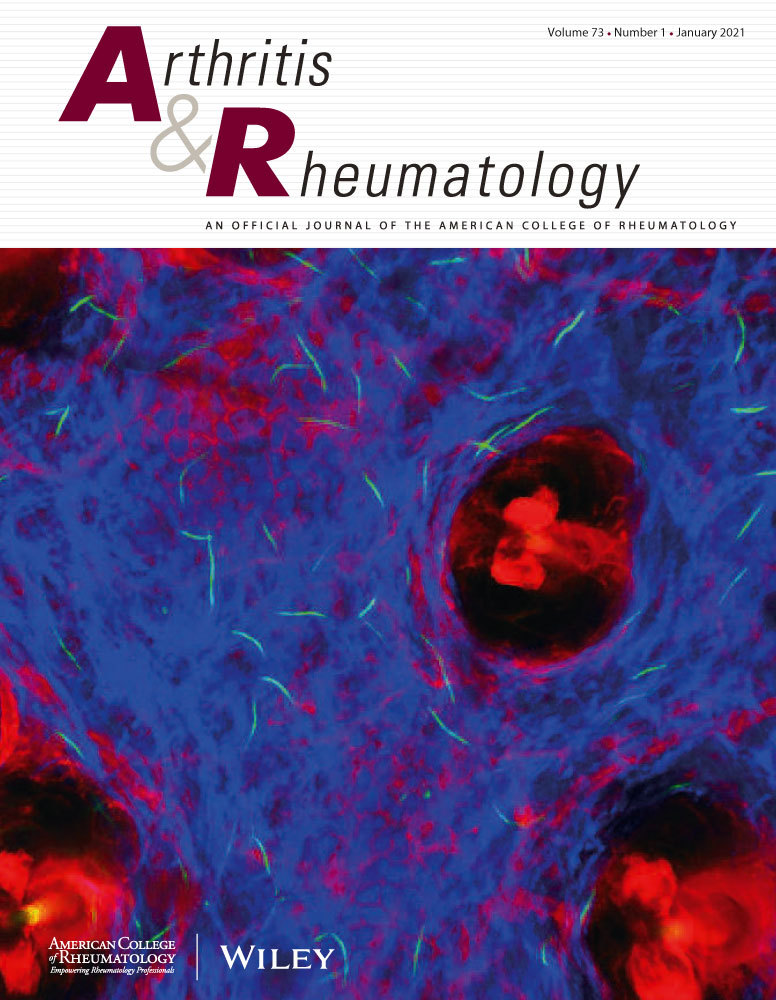Telomere Length of Peripheral Blood Leukocytes Predicts Disease Severity and Worse Survival in Systemic Sclerosis.
IF 10.9
1区 医学
Q1 RHEUMATOLOGY
引用次数: 0
Abstract
OBJECTIVE Peripheral blood leukocyte telomere length (PBL-TL) shortening is associated with systemic sclerosis related interstitial lung disease (SSc-ILD). However, its association with other organ involvement, disease severity, and survival remains unclear. This study aimed to define the relationship of TL with SSc-specific disease manifestations and outcomes. METHOD PBL-TL was measured by quantitative PCR in 244 patients with SSc and 314 healthy controls. Multivariate modeling was utilized to assess the association of PBL-TL with disease severity and event-free survival. Longitudinal changes in PBL-TL were measured in a subset of patients. Telomere length was quantified in SSc skin and lung tissues by telomere fluorescence in situ hybridization. RESULTS PBL-TL was significantly shorter in patients with SSc than healthy controls. Shortened PBL-TL was associated with presence and severity of ILD and pulmonary hypertension (PH) with the shortest PBL-TL found in subjects with concurrent ILD and PH (p=0.04). PBL-TL was not associated with skin disease or peripheral vascular disease. Shorter PBL-TL was associated with hospitalizations (p<0.01) and worse event-free survival (p=0.03). Patients with early SSc had a faster rate of PBL-TL shortening compared to patients with longer disease duration (p = 0.04). TL was shorter in SSc-ILD lung epithelial cells (p=0.01) while no difference was found in epithelial cells of SSc skin (p=0.82). CONCLUSION Short PBL-TL is associated with pulmonary disease severity and predicts worse SSc clinical outcomes. This study provides rationale to further investigate the role of telomere dysfunction in SSc pathogenesis and validate TL as a prognostic biomarker in SSc.外周血白细胞端粒长度预测系统性硬化症的疾病严重程度和较差的生存率。
目的外周血白细胞端粒长度(PBL-TL)缩短与系统性硬化症相关性间质性肺疾病(SSc-ILD)相关。然而,其与其他器官受累、疾病严重程度和生存率的关系尚不清楚。本研究旨在明确TL与ssc特异性疾病表现和预后的关系。方法采用定量PCR检测244例SSc患者和314例健康对照者的pbl - tl。采用多变量模型评估PBL-TL与疾病严重程度和无事件生存期的关系。在一部分患者中测量PBL-TL的纵向变化。采用端粒荧光原位杂交法定量测定SSc皮肤和肺组织的端粒长度。结果SSc患者的spbl - tl明显短于健康对照组。短PBL-TL与ILD和肺动脉高压(PH)的存在和严重程度相关,并发ILD和PH的受试者PBL-TL最短(p=0.04)。PBL-TL与皮肤疾病或周围血管疾病无关。较短的PBL-TL与住院相关(p<0.01)和较差的无事件生存相关(p=0.03)。与病程较长的患者相比,早期SSc患者的PBL-TL缩短速度更快(p = 0.04)。SSc- ild肺上皮细胞的TL较短(p=0.01),而SSc皮肤上皮细胞的TL无差异(p=0.82)。结论短PBL-TL与肺部疾病严重程度相关,并可预测较差的SSc临床预后。本研究为进一步研究端粒功能障碍在SSc发病机制中的作用以及验证TL作为SSc预后生物标志物提供了理论依据。
本文章由计算机程序翻译,如有差异,请以英文原文为准。
求助全文
约1分钟内获得全文
求助全文
来源期刊

Arthritis & Rheumatology
RHEUMATOLOGY-
CiteScore
20.90
自引率
3.00%
发文量
371
期刊介绍:
Arthritis & Rheumatology is the official journal of the American College of Rheumatology and focuses on the natural history, pathophysiology, treatment, and outcome of rheumatic diseases. It is a peer-reviewed publication that aims to provide the highest quality basic and clinical research in this field. The journal covers a wide range of investigative areas and also includes review articles, editorials, and educational material for researchers and clinicians. Being recognized as a leading research journal in rheumatology, Arthritis & Rheumatology serves the global community of rheumatology investigators and clinicians.
 求助内容:
求助内容: 应助结果提醒方式:
应助结果提醒方式:


